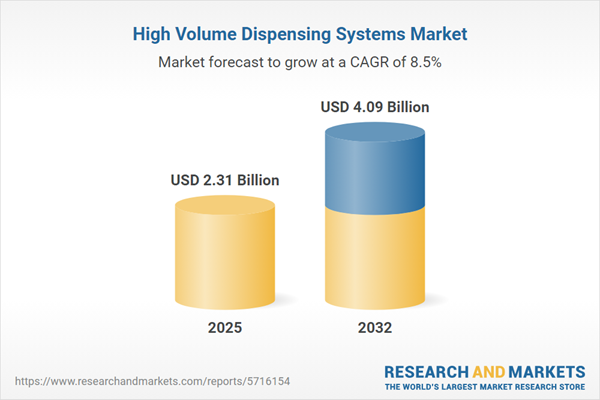Speak directly to the analyst to clarify any post sales queries you may have.
Senior executives navigating highly regulated markets are rapidly advancing automation within high volume dispensing systems, adapting to digital transformation and stringent compliance requirements. Strategic investment in advanced dispensing technologies is now central to achieving operational efficiency and ensuring regulatory alignment.
Market Snapshot: High Volume Dispensing Systems Market
The high volume dispensing systems market is experiencing robust expansion, supported by increased demand for precise, automated liquid handling across life sciences and industrial sectors. Organizations seek to standardize processes and reduce manual errors, pushing automation higher on the operational agenda. Current market activity centers on enhancing transparency and minimizing intervention, with flexibility and responsiveness becoming essential as companies anticipate regulatory and technological shifts. Adoption of modular system designs and interoperability is accelerating, positioning firms for competitive strength amid dynamic marketplace conditions.
Scope & Segmentation: High Volume Dispensing Systems Market
This report reviews the main drivers, applications, and selection factors defining the high volume dispensing systems market, equipping leaders with clear segmentation insights for effective planning:
- Application: High volume dispensing systems are essential across biotechnology, pharmaceutical manufacturing, laboratory research, clinical diagnostics, and industrial chemical production. Each application demands accuracy and robust compliance for smooth, efficient workflows.
- Technology: Solutions utilize centrifugal pumps, peristaltic pumps, reciprocating mechanisms, and syringe pumps. This technological diversity enables businesses to choose configurations best suited to their production and fluid handling needs.
- End User: Academic laboratories, government R&D centers, contract manufacturing organizations, pharmaceutical and biotechnology firms, and research institutes all depend on customized dispensing solutions that support throughput and industry regulations.
- Automation Level: Product offerings range from manual to semi-automated and fully automated, supporting flexible scaling and workforce optimization within varying operational structures.
- Region: The high volume dispensing systems market spans the Americas, Europe, Middle East and Africa, and Asia-Pacific, where local supply chains and regulatory frameworks drive market activity and decision-making.
- Companies Covered: Leading competitors include Danaher Corporation, Tecan Group AG, Thermo Fisher Scientific Inc., Agilent Technologies, PerkinElmer, Bio-Rad Laboratories, Sartorius AG, Eppendorf SE, Hamilton Bonaduz AG, and Gilson. This assists organizations in benchmarking and forming targeted partnership strategies.
Key Takeaways for Senior Decision-Makers
- Adoption of automation technologies redeploys personnel from repetitive tasks to higher-value initiatives, building stronger preparedness across compliance-heavy operations.
- Integrated advanced software streamlines onboarding, enhances process visibility, and enables swift adaptation through simplified regulatory documentation management.
- Modular and interoperable system architectures allow smooth scaling and workflow adjustments, reducing process interruptions and supporting ongoing operational investment.
- Robust supplier partnerships are vital for system reliability, operational continuity, and meeting quality standards during periods of rising regulatory expectations.
- Customizable dispensing platforms offer the flexibility required to adapt to production fluctuations and diverse liquid properties, ensuring ongoing suitability as standards evolve.
- Regional supply chain diversification mitigates risks tied to trade volatility and local disruptions, contributing to more stable procurement outcomes.
Tariff Impact and Supply Chain Strategies
Recent changes in U.S. tariff regulations are influencing component sourcing across the high volume dispensing systems market. Companies are increasingly opting for local sourcing strategies, applying just-in-time inventories, and deepening collaborations with domestic suppliers. These adaptations help maintain steady supply operations and protect material flows, even as global trade dynamics remain uncertain.
Methodology & Data Sources
This report compiles insights from direct interviews with leaders, engineers, and procurement experts active in pharmaceuticals, biotechnology, and research. Findings are thoroughly validated using regulatory documents, peer-reviewed studies, and patent data assessment, providing a reliable foundation for strategic planning.
Why This Report Matters
- Enables executives to align automation investments and compliance measures with long-term business objectives and market realities.
- Supports operational efficiency and risk management, while strengthening technology partnerships and diversifying supply chain strategies for improved resilience.
- Delivers regionally tailored recommendations supporting technology adoption and robust supplier relationships, allowing organizations to respond effectively to evolving regulatory demands.
Conclusion
This comprehensive overview equips senior leadership with a clear understanding of technology advances and supply chain tactics, helping organizations sustain growth and adapt to shifting industry and regulatory landscapes.
Additional Product Information:
- Purchase of this report includes 1 year online access with quarterly updates.
- This report can be updated on request. Please contact our Customer Experience team using the Ask a Question widget on our website.
Table of Contents
3. Executive Summary
4. Market Overview
7. Cumulative Impact of Artificial Intelligence 2025
Companies Mentioned
The companies profiled in this High Volume Dispensing Systems market report include:- Danaher Corporation
- Tecan Group AG
- Thermo Fisher Scientific Inc.
- Agilent Technologies, Inc.
- PerkinElmer, Inc.
- Bio-Rad Laboratories, Inc.
- Sartorius AG
- Eppendorf SE
- Hamilton Bonaduz AG
- Gilson, Inc.
Table Information
| Report Attribute | Details |
|---|---|
| No. of Pages | 182 |
| Published | November 2025 |
| Forecast Period | 2025 - 2032 |
| Estimated Market Value ( USD | $ 2.31 Billion |
| Forecasted Market Value ( USD | $ 4.09 Billion |
| Compound Annual Growth Rate | 8.4% |
| Regions Covered | Global |
| No. of Companies Mentioned | 11 |









